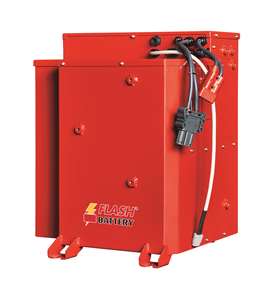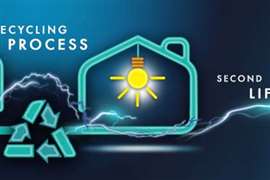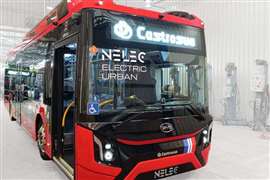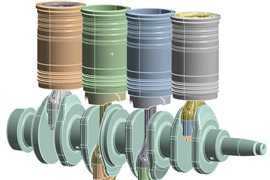Read this article in 中文 Français Deutsch Italiano Português Español
Thermal management for lithium batteries
26 March 2024
Lithium batteries are now used in many different applications, ranging from off-highway machinery through to agricultural vehicles, aerial platforms, airport ground support and marine applications. Each of these has its own requirements based on operating conditions.
 A Flash Battery lithium battery for industrial machine applications. (Photo: Flash Battery)
A Flash Battery lithium battery for industrial machine applications. (Photo: Flash Battery)
Temperature control, or thermal management, of the battery pack is a critical function, playing a crucial role in performance and total operating lifetime. Too low and it reduces the battery capacity; too high and it can cause degradation and reduce the number of potential recharging cycles.
Marco Righi, CEO and founder of Flash Battery, explained that the ideal temperature range for lithium batteries is between 20° and 35° C. “This does not mean that batteries cannot work at lower or higher temperatures, but that the expected battery lifetime will be impacted,” he said. “Considering that the lithium technology allows for over 4,000 cycles, even if a slight reduction of the operation lifetime is happening because of temperature range, batteries still can guarantee an appropriate duration for the lifetime of the vehicle.”
Cooling Systems
Cooling systems can have a significant impact on the cost of the entire battery system. As such, avoiding them can result in a significant cost savings.
According to Flash Battery, most off-highway applications don’t need a battery cooling system due to longer charge/discharge times. It is rapid cycling that can affect pack temperature and reduce maximum lifespan.
“A cooling system is usually necessary for applications requiring ultra-fast charging or in hybrid systems where the battery is discharged quite rapidly,” reported Righi. “Choosing large batteries means that the packs will not be stressed or overheated during use.”
Cooling systems can be implemented with a forced ventilation system; air cooling system inside the pack; or a liquid cooling system inside the pack. The best solution will depend on the application, the battery pack stress and forecast production numbers.
“For indoor applications, such as automated systems used in logistics, forced ventilation is usually enough,” said Righi. “For outdoor applications, a liquid cooling solution is usually required.”
Heating Systems
One of the limitations of lithium batteries is that they are unable to charge at a temperature below 0° C. In addition, if left at temperatures below 10° C, the internal resistance can suffer, resulting in a drop in voltage and efficiency loss. A heating system allows a vehicle to operate outside, regardless of the weather conditions.
Heating systems for batteries can be implemented in two different ways: using electric heating elements or with a fluid circuit. A heating system is highly recommended for lithium batteries in a hybrid or electric vehicle. Heating is controlled by the battery management system (BMS) according to operational need. A heating system can support battery performance and increase overall vehicle efficiency, particularly after a period of inactivity in low temperatures.
BMS for Safety
Flash Battery’s BMS monitors function of the packs across a series of parameters. If an overheating event occurs, it can sense if it is a single cell or if the temperature has increased across the entire battery pack.
If a single cell is involved, the BMS immediately interrupts the charge/discharge phase and issues a warning to prevent damage to the entire pack. More general overheating can be caused by an intensive use of the battery. In this case, the BMS interacts with the vehicle to reduce performance and avoid further temperature increases.
“A smart BMS works preventively to avoid overheating before it begins,” said Righi. “The most important function of the BMS is the balancing of the battery pack. Our proprietary Flash Balancing System acts both actively and passively with a much higher balancing power than traditional BMS (20A). It guarantees an ultra-rapid balancing and always ensures the maximum autonomy of the battery.”
Besides balancing, the BMS manages:
- all parameters of the battery in real time;
- the information to be sent to the vehicle’s control system, the engine management system or the display;
- the recharging system;
- the cooling and heating of the battery pack;
- and the predictive analysis of the health of the equipment powered by the battery.
POWER SOURCING GUIDE
The trusted reference and buyer’s guide for 83 years
The original “desktop search engine,” guiding nearly 10,000 users in more than 90 countries it is the primary reference for specifications and details on all the components that go into engine systems.
Visit Now
STAY CONNECTED




Receive the information you need when you need it through our world-leading magazines, newsletters and daily briefings.
CONNECT WITH THE TEAM













